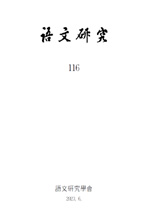- 영문명
- On the nagative affix ‘-can/chan-’ in Korean
- 발행기관
- 어문연구학회
- 저자명
- 최정윤(Jeong-yun Choi)
- 간행물 정보
- 『어문연구』第125輯, 121~146쪽, 전체 26쪽
- 주제분류
- 어문학 > 한국어와문학
- 파일형태
- 발행일자
- 2025.09.30

국문 초록
이 논문은 장형 부정의 준말로 알려진 ‘-잖/찮-’이 단어 형성에 관여하는 부정접사의 성격을 지닌다는 점을 밝히는 것을 목표로 하였다. 한글맞춤법에서는 ‘-잖/찮-’을 통사적 부정의 준말로 제시하고 있다. 종래 준말은 의미 변화를 초래하지 않으면서 형태가 줄어드는 언어형식으로 인식되었기에 선행 연구에서는 의미 변화를 초래하는 개별 단어들의 통시적 형성 과정이나 개별 어휘들의 어휘화 양상에 주목하였다. 그러나 본고에서는 준말 ‘-잖/찮-’이 단어 형성에 참여하는 요소로 접사적 성격을 지닌다고 논의하였다. 이를 위해 장형 부정문과 ‘-잖/찮-’ 파생어 문장을 비교하여 부정극어의 공기 여부와 부정의 작용역을 검증하였다. 장형 부정문은 부정문을 형성하나 ‘-잖/찮-’ 파생어는 부정문을 형성하지 못하고 부정의 작용역에 차이를 보인다는 점을 포착할 수 있었다. 이러한 차이를 통해 ‘-잖/찮-’이 부정접사로 기능한다는 점을 밝혔다.
부정접사의 의미를 논의하기 위해 통시적 과정에서 어휘화된 단어를 제외하고 공시적으로 의미 파악이 가능한 어기에 결합한 ‘-잖/찮-’ 파생어를 선정하여 어기의 특성을 분석하였다. 분석 결과, 부정접사 ‘-잖/찮-’과 결합하는 어기는 대부분 화자의 심리적 경험을 나타내는 어근과 결합한다는 점을 확인하였다. 심리 술어를 이루는 용언 어근 외에도 심리 표현 구문을 이루는 형용사나 상태성이 높은 동사가 부정접사 ‘-잖/찮-’과 결합하여 화자의 심리적 판단을 나타낸다는 양상을 확인할 수 있었다.
마지막으로 ‘-잖/찮-’의 의미는 (ⅰ) 부정접사 ‘-잖/찮-’이 긍정적 어근과 결합한 경우, ‘기준에 미치지 못함’, (ⅱ) 부정적 어기의 의미와 결합한 경우, ‘기준보다 더함’, (ⅲ) 사건에 대한 화자의 인식을 판단하는 어근과 결합한 경우, ‘모두 아님’의 의미로 해석된다는 점을 확인할 수 있었다. 이러한 논의는 장형 부정의 준말이 형식이 단어 형성하는 부정접사로 기능한다는 점과 통사적 부정에서 축약된 형태인 ‘-잖/찮-’의 부정의 의미는 어기의 의미 특성과 연관된다는 점을 시사한다.
영문 초록
This study examines the Junmal(reduced word) ‘-can/chan-’, traditionally regarded as a shortened form of long-form negation, and demonstrates that it functions as a negative affix in word formation. While Korean orthography treats ‘-can/chan-’ as a contraction of syntactic negation, contractions have generally been understood as phonological reductions that leave meaning unchanged. Consequently, prior research has focused mainly on the diachronic development and lexicalization of individual items. In contrast, this paper argues that ‘-can/chan-’ exhibits affixal properties, contributing directly to the morphological formation of words.
To this end, we tested the co-occurrence of negative polarity items in sentences and analyzed the role of negation, thereby confirming the distinction between long-negative sentences and those containing derivatives ‘-can/chan-’. We found that the difference in the scope of negation between long-negative sentences, which create sentential negation, and ‘-can/chan-’ derivatives which do not. These differences demonstrated that ‘-can/chan-’ functions as a negative affix.
To investigate the meaning of negative affixes, we selected ‘-can/chan-’ derivatives whose bases could be interpreted synchronically, excluding words lexicalized through diachronic processes, and analyzed the characteristics of their bases. The analysis revealed that most bases combining with the negative suffix ‘-can/chan-’ are roots expressing the speaker’s psychological experience. We confirmed that adjectives forming psychological expression constructions and verbs with a high degree of stativity combine with ‘-can/chan-’ to express the speaker’s psychological judgment, in addition to functioning as psych predicates.
Lastly, we demonstrated that the meaning of ‘-can/chan-’ is interpreted as (i) ‘not meeting the standard’ when the negative suffix ‘-can/chan-’ is combined with a positive root, (ii) ‘exceeding the standard’ when combined with the meaning of a negative root, and (iii) ‘not all’ when combined with a root that reflecting the speaker’s perception of an event. These findings suggest that the contradiction of long-form negation functions as a negative affix in word formation and that the meaning of the negative affix ‘-can/chan-’ is related to the semantic characteristics of its base.
목차
1. 서론
2. 장형 부정과 부정접사 파생어의 차이
3. 부정접사 ‘-잖/찮-’과 결합하는 어기
4. 부정접사 ‘-잖/찮-’의 의미 특성
5. 결론
참고문헌
키워드
해당간행물 수록 논문
참고문헌
최근 이용한 논문
교보eBook 첫 방문을 환영 합니다!

신규가입 혜택 지급이 완료 되었습니다.
바로 사용 가능한 교보e캐시 1,000원 (유효기간 7일)
지금 바로 교보eBook의 다양한 콘텐츠를 이용해 보세요!



